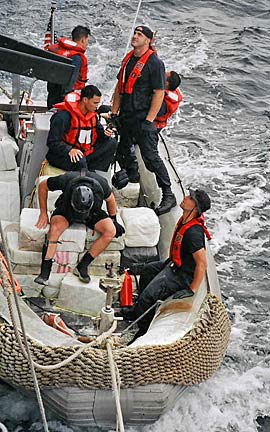
|
Ex-football star plays
offense on narcotics
Navy Ensign Justin Takasaki had a football dilemma last month.
The U.S. Naval Academy, where he had been a cornerback and a special teams kick returner for two years, was taking on archrival Army. And Kamehameha Schools, where he was an Interscholastic League of Honolulu all-star slotback in 1997, was facing Leilehua High School for the state championship.
"I really wanted to see that game (Leilehua vs. Kamehameha)," said Takasaki, 25. "But I was on the neighbor islands and I had to settle on watching the Army-Navy football game on TV."
In both cases, his alma mater prevailed -- Navy ran over Army 42-13 and Kamehameha won its first post-season crown since beating the Leilehua Mules in the 1974 Prep Bowl.
Takasaki is an officer on the guided-missile frigate USS Crommelin, which recently returned to its home port at Pearl Harbor. While at sea, Takasaki was responsible for the equipment and boats used during drug raids off Central and South America.
The Crommelin's deployment, which ended Nov. 12, resulted in the interception and recovery of 20 metric tons of cocaine worth more than $1 billion, the arrest of 29 alleged drug smugglers and the rescue of 96 people at sea.
One of the drug busts involved the fishing vessel San Jose on Sept. 24 and the recovery of 525 bales of cocaine weighing 20.5 metric tons, the third largest at-sea bust in U.S. history. It occurred 600 miles southwest of the Galapagos Islands. Eight suspects were arrested. Members of Kaneohe's Helicopter Antisubmarine Squadron Light 37 aboard the Crommelin assisted in the bust.
"Nothing can compare to a couple of these high speed chases," Takasaki said. "It was exciting. We were working with the USS Ticonderoga and chasing one of those 'go-fast' boats used by the drug smugglers.
"It was at night when our ship turned. My crew found ourselves close to the water since we were out on deck. We could see the tracers of the Ticonderoga's warning shots.
"But then there were days at sea when we didn't do anything. There were at least 1,000 hours of preparation that came into play in a few hours."
Takasaki estimated that the Crommelin tracked at least 80 small vessels, but boarded and searched only eight.
The Crommelin's first drug bust occurred June 22, seven weeks after it left Pearl Harbor, when it and the cruiser USS Ticonderoga recovered a total of 72 cocaine bales weighing more than 50 pounds each. The drugs had an estimated street value of $115 million.
A week later on June 29, the Crommelin seized an additional 50 bales of cocaine together weighing more than 1 ton, valued at $67 million. The bust resulted in the arrest of 20 suspects in waters southwest of Costa Rica, close to Panama.
Takasaki's tour on the Crommelin will end in December and he doesn't know whether he will make the Navy a career.
At the moment, Takasaki and his wife of eight months, Lisa, are taking advantage of the Crommelin's post-deployment stand-down and holiday leave. The Crommelin isn't expected to deploy again until next summer.
[News] [Business] [Features] [Sports] [Editorial] [Do It Electric!]
[Classified Ads] [Search] [Subscribe] [Info] [Letter to Editor]
[Feedback]
